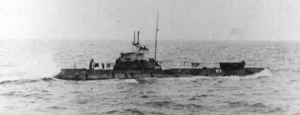HMS H1

| |
| History | |
|---|---|
| Name | HMS H1 |
| Builder | Canadian Vickers, Montreal |
| Laid down | 11 January 1915 |
| Commissioned | 26 May 1915 |
| Fate | Sold, 7 March 1921 |
| General characteristics | |
| Class and type | H class submarine |
| Displacement |
|
| Length | 150 ft 3 in (45.80 m) |
| Beam | 15 ft 4 in (4.67 m) |
| Propulsion |
|
| Speed |
|
| Range |
|
| Complement | 22 |
| Armament |
|
HMS H1 was a British H-class submarine built by Canadian Vickers Co., Montreal. She was laid down on 11 January 1915 and was commissioned on 26 May 1915. H1 crossed the Atlantic from St John's, Newfoundland to Gibraltar escorted by the armed merchant cruiser HMS Calgarian. She was accompanied by H2, H3 and H4. H1 mistakenly sank H5 off Cattaro on 15 April 1918. H1 was sold on 7 March 1921 in Malta.
Design
Like all pre-H11 British H-class submarines, H1 had a displacement of 364 tonnes (401 short tons) at the surface and 434 tonnes (478 short tons) while submerged.[2] It had a total length of 171 feet (52 m),[3] a beam length of 15 feet 4 inches (4.67 m), and a draught length of 12 feet (3.7 m).[4] It contained a diesel engines providing a total power of 480 horsepower (360 kW) and two electric motors each providing 320 horsepower (240 kW) power.[4] The use of its electric motors made the submarine travel at 11 knots (20 km/h; 13 mph). It would normally carry 16.4 tonnes (18.1 short tons) of fuel and had a maximum capacity of 18 tonnes (20 short tons).[5]
The submarine had a maximum surface speed of 13 knots (24 km/h; 15 mph) and a submerged speed of 11 knots (20 km/h; 13 mph). British H-class submarines had ranges of 1,600 nautical miles (3,000 km; 1,800 mi).[2] H1 was fitted with a 6 pounds (2.7 kg) Hotchkiss quick-firing gun gun (6-pounder) and four 18 inches (460 mm) torpedo tubes. Its torpedo tubes were fitted to the bows and the submarine was loaded with eight 18 inches (460 mm) torpedoes.[2] It is a Holland 602 type submarine but was designed to meet Royal Navy specifications. Its complement was twenty-two crew members.[2]
References
- ^ Britain 6-pdr / 8cwt [2.244"/40 (57 mm)] QF Marks I and II
- ^ a b c d "H-class". Battleships-Cruisers, Cranston Fine Arts. Retrieved 20 August 2015.
- ^ Derek Walters (2004). The History of the British 'U' Class Submarine. Casemate Publishers. pp. 2–. ISBN 978-1-84415-131-8.
- ^ a b Colledge, J. J.; Warlow, Ben (2006) [1969]. Ships of the Royal Navy: The Complete Record of all Fighting Ships of the Royal Navy (Rev. ed.). London: Chatham Publishing. ISBN 978-1-86176-281-8. Retrieved from Naval-History on 20 August 2015.
- ^ J. D. Perkins (1999). "Building History and Technical Details for Canadian CC-Boats and the Original H-CLASS". Electric Boat Company Holland Patent Submarines. Retrieved 20 August 2015.
- Hutchinson, Robert. Submarines, War Beneath The Waves, From 1776 To The Present Day.
